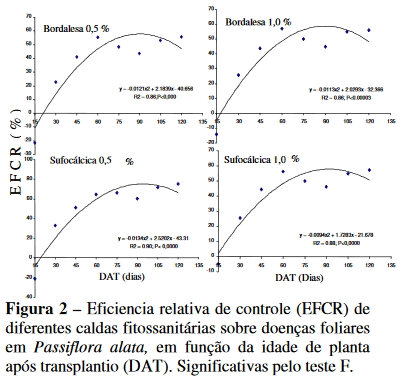Efficiency of broth and sulfocalcium syrup at different concentrations and plant age in the control of sweet passion fruit leaf diseases in organic cultivation
DOI:
https://doi.org/10.20873/jbb.uft.cemaf.v3n2.mingKeywords:
Passiflora allata Dryander, plant diseases control, medicinal plants, agroecological croppingAbstract
The complex of leaf diseases that affect the passion fruit culture, especially the passion fruit (Passiflora allata) compromise the productivity and quality of fruits and their photosynthetic surfaces. However, P. allata is also used as a medicinal product, the leaves being the part used for this purpose. Thus, the focus of studies on the agronomic management of P. allata for the production of pharmaceutical raw materials differs, at least in part, from the focus on fruit production. Therefore, we evaluated the effect of broth and sulfoccal lime in different concentrations and ages of plants on diseases causing leaf blight of P. allata. The experiment was carried out under randomized block field conditions with five treatments and five replications of 10 plants each. The treatments were: a) Bordeaux syrup at 0.5 and 1.0%; b) 0.5 and 1.0% sulfocalcium syrup from a 27 ° Baumé matrix solution and c) control (without spraying). Treatment with 05% sulfocalcium spray promoted the lowest disease index and the highest relative control efficiency associated with the lower rate of disease development with the age of the crop.
References
Dias, M.S.C. (2000), Principais doenças fúngicas e bacterianas do maracujazeiro. In: Informe Agropecuário. A cultura do maracujá. Belo Horizonte: EPAMIG, 38p.
Kavati, R. and Piza-Júnior, C. T. (2002), Cultura do maracujazeiro-doce. Campinas: SAA/CATI, Boletim Técnico, 244, 46p.
Kimati, H. (1995), Controle químico. In: Bergamin Filho, A.; Kimati, H.; Amorim, L. Manual de fitopatologia: princípios e conceitos.3. Ed., São Paulo: Agronômica Ceres,761-785.
Pereira, C. A. M. e Vilegas, J. H. Y. (2000), Constituintes Químicos e Farmacologia do Gênero Passiflora com Ênfase a P. Alata Dryander., P. edulis Sims e P. incarnata L. Revista Brasileira de Plantas Medicinais, 3, 1- 12.
Pio-Ribeiro, G. e Mariano, L. R. Doenças do maracujazeiro. In: Kimati, H.; Amorim, L.; Bergamin Filho, A.; Camargo, L. E. A.; Rezende, J. A. M. (1997), Manual de fitopatologia: doenças das plantas cultivadas. 3. Ed., São Paulo: Agronômica Ceres, 525-534.
Souza, J. L. and Resende, P. (2003), Manual de Horticultura Orgânica, Editora Aprenda Fácil, Viçosa, MG, 560 p.
Vasconcelos, M. A. da S. Biologia floral do maracujá doce (Passiflora alata Dryand) nas condições de Botucatu - SP. Dissertação ( Mestrado em Ciências Agrárias) - Universidade Estadual de São Paulo, 1991.
Yamashiro, T. (1991), Principais doenças fúngicas e bacterianas no maracujazeiro encontradas no Brasil. In: São José, A. R. (1991), A Cultura do maracujá no Brasil, Jaboticabal, FUNEP, 169-174.
Zuin, A. G., Yariwake, J. H., Bicchi, C. Avaliação da transferência de pesticidas organoclorados e organofosforados da droga vegetal para o chá no processo de infusão de Passiflora alata L. In: Anais do V Jornada Paulista de Plantas Medicinais: Natureza, Ciência e Comunidade, Resumos, Botucatu, Unesp, (2001).

Published
How to Cite
Issue
Section
License
Copyright (c) 2024 - Journal of Biotechnology and Biodiversity

This work is licensed under a Creative Commons Attribution 4.0 International License.
Authors who publish with this journal agree to the following terms:
Authors retain copyright and grant the journal right of first publication with the work simultaneously licensed under a Creative Commons Attribution License (CC BY 4.0 at http://creativecommons.org/licenses/by/4.0/) that allows others to share the work with an acknowledgement of the work's authorship and initial publication in this journal.
Authors are able to enter into separate, additional contractual arrangements for the non-exclusive distribution of the journal's published version of the work (e.g., post it to an institutional repository or publish it in a book), with an acknowledgement of its initial publication in this journal.
Authors are permitted and encouraged to post their work online (e.g. in institutional repositories or on their website) prior to and during the submission process, as it can lead to productive exchanges, as well as earlier and greater citation of published work (Available at The Effect of Open Access, at http://opcit.eprints.org/oacitation-biblio.html).


